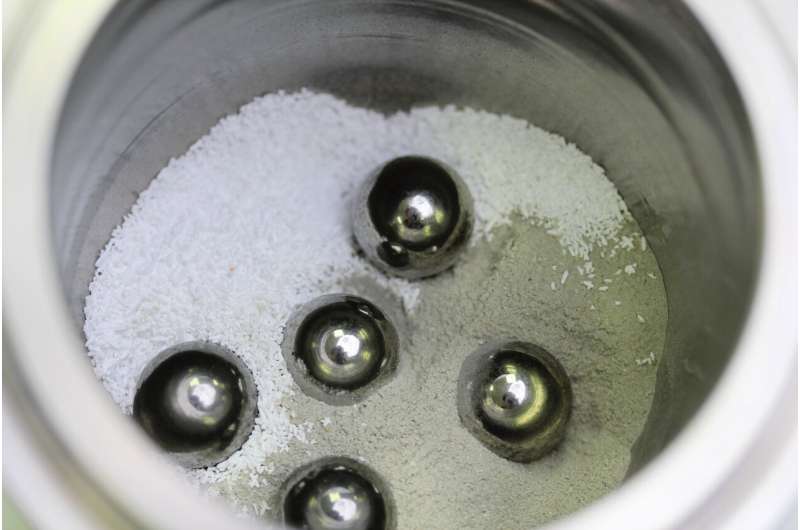
When people think of chemistry, the image that typically comes to mind is a variety of colored liquids in beakers, flasks, and test tubes in a lab. But in actual practice, chemistry can involve materials in all states: liquids, gases, and even solids.
Scientists at the Critical Materials Innovation (CMI) Hub, led by the U.S. Department of Energy's Ames National Laboratory, are using a subdiscipline of chemistry called mechanochemistry that literally shakes up the conventional understanding of chemical reactions, using mechanical forces that agitate, tumble, and smash solids to initiate chemical reactions. Their new process, mechanochemical extraction of lithium at low temperatures, or MELLT, is a creative solution to increase and diversify the supply of lithium in the United States.
Lithium is a high-demand element with an associated supply chain risk. It is needed for high-performance rechargeable batteries found in technologies such as cell phones, medical devices, and electric vehicles, to name a few. As electric vehicles become more popular, the demand for lithium increases. The lithium element (Li) needed to make these batteries comes from two sources: brines and hard-rock minerals. Lithium brines are deposits of salty groundwater that have accumulated dissolved lithium. The main hard-rock mineral that contains lithium is called spodumene. Both sources require different extraction methods.
Ihor Hlova, a CMI and Ames Lab scientist and the project group leader, explained that extracting lithium from brines is a cost-effective process that is based on solar evaporation. Basically, shallow wells filled with the brine are continuously exposed to open air to let the water evaporate. It is the primary source for both imported and domestic lithium in the United States.
The current method for extracting lithium from the hard-rock mineral spodumene is energy-intensive and produces greenhouse gases and hazardous waste streams. In this process, mineral ore is heated twice. The first time it is roasted at 1050°C (1976°F) to convert it to a state that is more suitable for chemical processing. In the second round, the mineral ore is cooked around 250°C (485°F) along with chemicals to form a water-soluble lithium compound. The resulting lithium product is higher quality than lithium extracted from brines.
Both methods present challenges in a high-demand market for Lithium; brines take too long to produce (12-24 months), and hard-rock mineral extraction uses too much energy. Additionally, brines require large amounts of fresh water at various stages of processing, while direct mineral extraction produces toxic by-products.
To bypass these downsides and create a more efficient process, Hlova's group used mechanochemistry.
"Mechanochemistry is an underutilized technique in extraction methodologies," said Tyler Del Rose, a postdoctoral researcher at Ames Lab and member of the research team. "Usually it is used to crush the initial material or mix the reactants, but in rare instances it has been used to facilitate chemical reactions."
All chemical reactions need energy. That energy can come in many forms, like heat, light, or electricity. But in the case of mechanochemistry, it comes from mechanical forces. "Mechanical force causes structural imperfections on the surface of solid materials," said Hlova. "These imperfections become reactive spots where chemical reactions can happen more quickly and easily."
Using these principles, Hlova's team developed MELLT. In a process called ball milling, solid spodumene chunks and a solid reactant chemical, like sodium carbonate (Na2CO3), are placed into a chamber with steel balls. The chamber is moved in different ways, causing rapid, repetitive shear and impact stresses among the materials. Repeated stress eventually leads to high-energy states within the chemicals, causing them to react with each other. These reactions result in water-soluble lithium compounds. These lithium compounds are extracted from the final product with a water wash.
MELLT streamlines hard-rock mineral extraction, uses significantly less energy, and eliminates toxic waste streams. MELLT is also much faster than brine extraction methods.
"Mechanochemistry offers a more sustainable and environmentally friendly approach to conducting chemical reactions," said Hlova. "This project offers the potential to diversify lithium supply chains in the U.S., reducing lithium criticality and paving the way for a sustainable future."
The development of MELLT is part of a larger collaborative effort supported by CMI involving multiple national laboratories, universities, and industry partners to discover new refining processes or to improve existing methods of extracting lithium from both hard rock and brine sources.
"CMI exists to develop innovative solutions to critical supply chain issues like this one, said Tom Lograsso, CMI director. "This work is part of that mission, providing U.S. industries with technologies that are available for commercialization."
Citation: Scientists are shaking up lithium extraction with a different kind of chemistry (2024, April 27) retrieved 27 April 2024 from https://techxplore.com/news/2024-04-scientists-lithium-kind-chemistry.html
This document is subject to copyright. Apart from any fair dealing for the purpose of private study or research, no part may be reproduced without the written permission. The content is provided for information purposes only.
